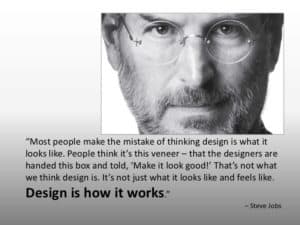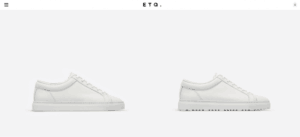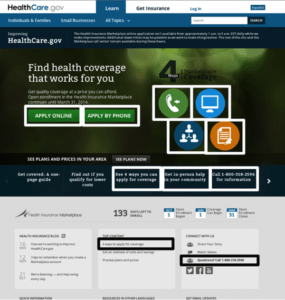10 Principles of Good Website Design

Much before the modern-day technology giant Apple began propagating the “Design Thinking” philosophy and gave to the world some iconic design marvels came a German Industrial Designer by the name of Dieter Rams.

With more than 40 years of experience Dieter Rams spent at the consumer products company Braun, ended up establishing him as one of the most influential designers of the 20th Century and someone who is still admired by the who’s who of the design world.
One of the biggest compliments to Rams’ legacy comes from none other than a modern great Jony Ive, Apple’s Chief Design Officer, who has gone on record to acknowledge the genius of the German designer and how he has been inspired by his work.

Jonathan Ive’s praise for Dieter Rams is reason enough for us to dive deep into the design ideology propagated by the latter and see how these fundamental design principles still have relevance in the world of design and especially in Ecommerce website designing.
10 Principles of Good Design
Quoted below are the views of Dieter Rams on each of the 10 Commandments of Good Design as professed by him and alongside are the key takeaway that we believe can be applied to the field of web design.
#1. Good Design is Innovative
“The possibilities for innovation are not, by any means, exhausted. Technological development is always offering new opportunities for innovative design. But innovative design always develops in tandem with innovative technology, and can never be an end in itself.”
Our takeaway: Innovation must remain at the core of web design strategies. Whether the objective is to give a major facelift to an existing website or start a web design project from scratch, innovative website designers will always look to explore new and emerging technology to their advantage and use it for better design outcomes. A groundbreaking design should be relevant to the current trends, be timeless, and most importantly demonstrate “design thinking” or a solution-based thinking for an improved UX.
Example of an innovative web design:

See how beautifully the logo of JPMorgan Chase Bank on their website transforms into a logomark as the banner turns blue.
#2. Good Design Makes a Product Useful
“A product is bought to be used. It has to satisfy certain criteria, not only functional, but also psychological and aesthetic. Good design emphasizes the usefulness of a product whilst disregarding anything that could possibly detract from it.”
Our takeaway: This quote from the Late Steve Jobs sums it up beautifully to bring home the importance of functionality in designing:

#3. Good Design is Aesthetic
“The aesthetic quality of a product is integral to its usefulness because products we use every day affect our person and our well-being. But only well-executed objects can be beautiful.”
Our takeaway: One of the best practices of web design is that everyone tends to focus a lot today is the aesthetic appeal. And rightly so! Unless a website is visually appealing it will not be able to retain those all-important visitors on the website.
#4. Good Design Makes a Product Understandable
“It clarifies the product’s structure. Better still, it can make the product talk. At best, it is self-explanatory.”
Our takeaway: Your website design or web application should make it pretty clear on what’s being presented and how it can be used. Your site’s navigation for instance should be simple and designed to improve the user experience of your website visitors. There should not be any gap between what a user perceives from a design and what the design is capable of delivering.
Example:

The award-winning design of ETQ online store is a good example of how an ecommerce web design with compelling visuals and bold typography can help clarify the product’s structure and make the product talk.
#5. Good Design is Unobtrusive
“Products fulfilling a purpose are like tools. They are neither decorative objects nor works of art. Their design should therefore be both neutral and restrained, to leave room for the user’s self-expression.”
Our takeaway: A design that is not designer-driven but user-focused is the key. You must aim to create a website design that gets out of the way of a user and puts them in firm control of what they want to do. A neutral and restrained design therefore should be the central focus of your website design strategy.
#6. Good Design is Honest
“It does not make a product more innovative, powerful or valuable than it really is. It does not attempt to manipulate the consumer with promises that cannot be kept.”
Our takeaway: An honest design is the one that should not be deceptive to a user. That is, it must perform exactly as per the expectation of the users. “What you see is What it does”, therefore should be the guiding principle for web designers to focus on during the design and development phase.
#7. Good Design is Long-Lasting
“It avoids being fashionable and therefore never appears antiquated. Unlike fashionable design, it lasts many years – even in today’s throwaway society.”
Our takeaway: Many web designers end up falling for the pressures of incorporating all the latest web design trends possible. To qualify as a good design, it needs to be timeless and one that germinates out of a select few trends that have the potential to stand the test of time.
#8. Good Design is Thorough Down to the Last Detail
“Nothing must be arbitrary or left to chance. Care and accuracy in the design process show respect towards the user.”
Our takeaway: A good usability testing is the differentiating factor between good designers and excellent designers. Every minute detail on the website must be put to test thoroughly and it is therefore a good idea to take the initial iterations to people outside the core design team and possibly end users who can share invaluable initial feedback to help it improve and turn into a robust design that works seamlessly for visitors.
Example:
The debacle of the Obamacare’s Healthcare.Gov, a health insurance exchange website is well-documented and an apt case study on how usability testing is the key for any web design and development team. The portal also had several design flaws which came in for much criticism from design experts all over the world. As you will see from the image below, there was too much of information in the form of text and links in the homepage design.

#9. Good Design is Environmental Friendly (Conserves Resources)
“Design makes an important contribution to the preservation of the environment. It conserves resources and minimizes physical and visual pollution throughout the lifecycle of the product.”
Our takeaway: To put this point in context to website designing, it is important to create web designs that require little to no effort while scaling up. Be it by utilizing templates or falling back on a code library, there are many ways in which the time and effort that goes in web design and development can be reduced. Web Designers must also look to leverage popular web design tips and best practices to their advantage to eliminate duplication of effort and conserve their time.
#10. Good Design is as Little Design as Possible
“Less, but better – because it concentrates on the essential aspects, and the products are not burdened with non-essentials. Back to purity, back to simplicity.”
Our takeaway: Focusing on the most important aspects of web design and ignoring the non-essential elements is the key and a skill every web designer must possess. A good design therefore should aim to make the interaction process seamless for a user so that they can effortlessly browse it and complete their intended actions with effervescent ease.
Conclusion
About time, we break stereotypes around website designing. It needs to be understood that Website Designing is a creative process and a one-size-fits-all approach cannot work. Every company has a set of unique requirements which are in line with the business vision they have and those need to be represented through the web design elements. A good web design company offering Ecommerce solutions must look to reflect this unique need in the designs they create. A quality website design is therefore one that follows to the letter these 10 principles of good design as made famous by Dieter Rams.
Source: techmagnate.com



